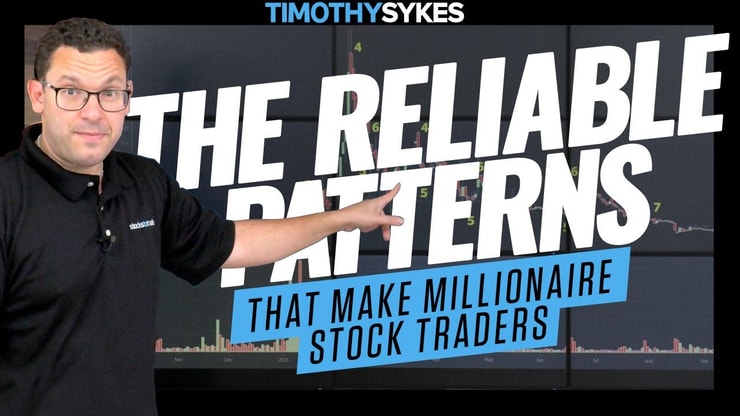The bearish engulfing candle is part of a larger pattern that could signal lower prices. It gets its name due to the shape of the candlestick chart pattern, and its relationship to the chart around it.
I’ll explain everything, don’t worry.
I know a lot of this financial jargon is confusing at first.
Imagine trying to teach yourself back when the internet was just getting started … That’s how I learned to trade. It was a little over two decades ago.
Believe me, it’s way easier to learn this stuff now. I already have more than 30 millionaire students!
That’s mostly due to the advance of technology.
I’ve found the more I can share with my students, the better they learn. In the beginning, I would hand out DVDs.
But now I can screen share and live stream my whole trading day.
You don’t have to learn this stuff by yourself.
I’ve been where you are, and I’ve helped tons of people just like you. Let’s get started.
Here’s what you need to know about bearish engulfing candles …
Table of Contents
- 1 What Is a Bearish Engulfing Candle?
- 2 What Is the Difference Between a Bearish and a Bullish Engulfing Candlestick Pattern?
- 3 Identification and Interpretation of Bearish Engulfing Patterns
- 4 Trading the Bearish Engulfing Candle
- 5 Risk Management When Trading Bearish Engulfing Pattern
- 6 Importance and Limitations of Engulfing Patterns
- 7 Key Takeaways
- 8 Frequently Asked Questions (FAQs)
- 8.1 How Can Traders Confirm Bearish Engulfing Candlestick Pattern Validity?
- 8.2 How Can a Bearish Engulfing Candlestick Pattern Be Used in Technical Analysis?
- 8.3 Are There Any Other Types of Bearish Engulfing Candlestick Patterns?
- 8.4 How Can the Bearish Engulfing Candle Be Identified Using Chart Patterns and What Are Its Main Formations?
- 8.5 What Trading Platforms and Trading Products Are Best Suited for Analyzing the Bearish Engulfing Candle Pattern?
- 8.6 Where Can Beginners and Investors Find Examples, Guides, and Content Related to the Bearish Engulfing Candle?
- 8.7 How Can the Bearish Engulfing Candle Pattern Be Used in a Trading Strategy, Considering Factors Like Entry Points and Time Frames?
- 8.8 How Do Candlesticks, Including Patterns Like the Morning Star, Relate to the Bearish Engulfing Candle in Trading?
- 8.9 What Role Does a Company’s Profit and the Amount of Profits Influence the Formation of a Bearish Engulfing Candle?
- 8.10 How Can Clients Use the Trading Calendar and Contact Number To Optimize Trading With the Bearish Engulfing Candle Pattern?
- 8.11 What’s the Importance of Acknowledging ‘Everything’ in Trading, From the Trader’s Name to Expressing Thanks and Considering Others’ Perspectives?
What Is a Bearish Engulfing Candle?

The bearish engulfing candle is a candlestick pattern where the body of a particular candle overshadows or engulfs the body of the previous candle. It’s a top reversal pattern, usually occurring after an uptrend.
But what’s inside this pattern? Let’s break it down.
First, recognize that the bearish engulfing candle doesn’t act alone. It’s part of a formation that includes a smaller bullish candle followed by a larger bearish candle.
The bearish candle’s body engulfs the previous candle’s body, thus signaling a potential reversal from a bullish to a bearish trend.
While the bearish engulfing candle is a powerful tool in predicting market downturns, it’s crucial to be aware of other market patterns that could affect your trading decisions.
For instance, the bull trap is a deceptive pattern that could lead traders to believe a stock’s price is on the rise when, in fact, it’s about to drop. Understanding how a bull trap works could help you avoid falling into one.
Psychology of Bearish Engulfing Pattern
The psychology behind this pattern isn’t as complex as it might seem. It’s about market sentiment and understanding the pressures at play.
When you see a bearish engulfing pattern, you’re witnessing a change in control. The bears, or sellers, are taking charge.
First, there’s optimism. The bulls are in control, and the price is moving up. But then, something shifts. The following candle opens higher but closes much lower, engulfing the previous candle.
This is the moment the market sentiment changes. The bears have stepped in, and they’re driving the price down.
This shift isn’t just a blip on the chart; it’s a signal, a sign of change. For traders, recognizing this pattern provides an opportunity to adjust positions, perhaps to trade bearish on the asset.
What Is the Difference Between a Bearish and a Bullish Engulfing Candlestick Pattern?

In the trading world, direction matters. Knowing the difference between a bearish and bullish engulfing candlestick pattern can mean the difference between gains and losses.
A bearish engulfing pattern signals a potential downturn, a reversal from an uptrend. It represents sellers taking control. On the other hand, a bullish engulfing pattern signifies a possible upward move, a reversal from a downtrend. It’s the buyers stepping in, seizing control.
Understanding these patterns, their differences, and what they signify is not just about reading charts; it’s about making informed trading decisions.
It’s about recognizing opportunities in the forex market, stocks, or commodities and taking action based on solid analysis.
One of the best times to watch for opportunities is during Friday’s market hours. There’s a lot of volatility on Fridays…
Click here for my favorite pattern to trade every Friday.
As you navigate the world of trading, you’ll encounter a variety of candlestick patterns, each with its unique implications.
For instance, the shooting star candle is another bearish pattern that could signal a price reversal. Much like the bearish engulfing candle, the shooting star candle can provide valuable insights into market trends and potential shifts in price direction.
Identification and Interpretation of Bearish Engulfing Patterns
Identification of a bearish engulfing pattern isn’t about chance; it’s about observing specific attributes in the candles.
From forex to cryptocurrencies, this pattern is universally applicable.
Yes, my students have used these patterns to trade crypto before. If you don’t believe me, watch the video below …
But let’s get into the specifics of bearish engulfing patterns.
How Do You Identify a Bearish Engulfing Candlestick Pattern?
Identifying a bearish engulfing candlestick pattern requires attention to details.
Look for an uptrend, followed by a small bullish candle, and then a large bearish candle that engulfs the previous one. The bearish candle’s open should be higher than the previous candle’s close, and its close should be lower than the previous candle’s open.
But it’s not enough to simply spot these attributes; interpretation plays a crucial role as well.
More Breaking News
- Is It Time to Jump on INTZ’s Recent Stock Surge?
- The Soaring Heights and Bumpy Lows of SoundHound AI: Unraveling December’s Financial Narrative
- Opendoor Technologies’ CEO Stock Sale Sparks Speculation Amid Stock Volatility
How Do You Interpret a Bearish Engulfing Candlestick Pattern?
Interpreting this pattern is about understanding what it signals: a potential trend reversal.
The bears are exerting pressure, and a downtrend may be on the horizon. This isn’t investment advice, but rather an analysis based on historical patterns.
Using this in conjunction with other technical analysis tools and indicators can strengthen your trading decisions.
Trading the Bearish Engulfing Candle

Trading the bearish engulfing candle isn’t a step into the unknown; it’s a strategy based on observable patterns and sound judgment.
There are a lot of things new traders need to know before they can truly make a well-informed trade.
The issue is … very few people teach the necessary skills.
In fact, I stand out in this market like a sore thumb. A penny-stock trader that shares all his trades including the losses.
That’s probably why my students are so successful. I’m honest with them so they have a healthy perspective on these opportunities.
Here’s where all my millionaire students started.
In addition to recognizing patterns like the bearish engulfing candle, it’s also essential to consider the broader market context.
One common adage among traders is ‘Buy the rumor, sell the news.’ This strategy involves trading based on rumors about future events and then selling once the actual news breaks.
Understanding how to effectively sell the news can complement your use of candlestick patterns and help you make more informed trading decisions.
How Do You Trade Using a Bearish Engulfing Candlestick Pattern?
Trading using this pattern requires knowing when to enter and when to exit.
Timing and confirmation are key. Look for the pattern at the top of an uptrend and consider additional confirmation such as increased volume or other technical indicators.
There are similarities between patterns like a high share volume. For the top patterns right now, watch the video below …
Certain factors make a big difference when we’re trading.
This isn’t about gut feeling; it’s about precision.
Bearish Engulfing Pattern Trading Strategies
The strategies to trade a bearish engulfing pattern can be as varied as the market participants themselves.
Let’s examine a couple of them.
Strategy #1: Bearish engulfing in the area of high prices
Identifying this pattern at high prices can signal a strong reversal.
But it’s not about jumping in blindly. Wait for confirmation, understand the risk management involved, and ensure it aligns with the overall market conditions. It’s about context, not mere reaction.
Strategy #2: Trading a bearish engulfing pattern with confirmation
Trading this pattern with confirmation, such as a follow-through bearish candle or a strong resistance level, adds strength to the signal.
It’s not just about spotting the pattern but understanding what supports it. Utilizing stop loss and other risk management tools here is not an option; it’s essential.
Risk Management When Trading Bearish Engulfing Pattern

In the ever-changing world of trading, whether it’s stocks, forex, or commodities, risk management isn’t an afterthought; it’s a necessity.
Day trading can lead to substantial losses.
A 2019 study called “Day Trading for a Living?” looked at the success rates of Brazilian traders over a 2-year window, and found that 97% of traders with more than 300 days of active trading lost money. Only 1.1% earned more than the Brazilian minimum wage — that’s only $16 per day!
Let’s delve into the risks and strategies associated with trading the Bearish Engulfing Pattern.
What Are the Risks Associated With Trading a Bearish Engulfing Candlestick Pattern?
The bearish engulfing candlestick pattern, though a sign of potential trend reversal, comes with risks.
Market sentiment can change, other market participants may see things differently, or news might affect price action. It’s not about fearing the market but recognizing the dynamics that come into play.
Risk Management Strategies When Trading Bearish Engulfing Candle
When trading the bearish engulfing pattern, having risk management strategies is non-negotiable.
Employ stop-loss orders, assess the strength of the trend, and use only a portion of your trading account for each position. Risk isn’t a word to be taken lightly here; it’s the defining factor of trading success or failure.
Importance and Limitations of Engulfing Patterns
Engulfing patterns, whether bearish or bullish, are tools in a trader’s toolbox.
Understanding their importance and limitations is key to effective use.
Bearish Engulfing Pattern Reliability
The reliability of the bearish engulfing pattern varies with the context and confirmation.
It’s not a silver bullet; it’s a signal enhanced by other indicators and market analysis. Used wisely, it’s a strong tool.
Used blindly, it’s a path to losses.
Pros of Bearish Engulfing Candle Patterns
The pros? They provide early warning signs of potential trend reversals and can be found in various assets, from commodities to cryptocurrencies.
But it’s not about the pros alone; the cons need equal attention.
Cons of Bearish Engulfing Patterns
The cons? They can sometimes lead to false signals, especially if traded without confirmation or in a low-volume market.
Remember, every signal, every pattern, every analysis comes with limitations. It’s not a flaw; it’s the nature of trading.
Key Takeaways

Engulfing patterns, especially bearish engulfing patterns, are valuable for identifying potential trend reversals.
But they aren’t standalone signals.
Risk management, understanding market conditions, using additional indicators, and trading strategies are all part of the equation.
It’s not a one-size-fits-all approach; it’s a thoughtful, precise way of trading.
Trading isn’t rocket science. It’s a skill you build and work on like any other. Trading has changed my life, and I think this way of life should be open to more people…
I’ve built my Trading Challenge to pass on the things I had to learn for myself. It’s the kind of community that I wish I had when I was starting.
We don’t accept everyone. If you’re up for the challenge — I want to hear from you.
Apply to the Trading Challenge here.
Trading is a battlefield. The more knowledge you have, the better prepared you’ll be.
Do you think you’ll use the bearish engulfing pattern in your trading strategy? If so, how? Let me know in the comments — I love hearing from my readers!
Frequently Asked Questions (FAQs)
How Can Traders Confirm Bearish Engulfing Candlestick Pattern Validity?
Confirmation can come from additional bearish candles, increased volume, resistance levels, and other technical analysis tools.
It’s about building a case, not jumping on a single sign.
How Can a Bearish Engulfing Candlestick Pattern Be Used in Technical Analysis?
It’s used to spot potential downtrends, often in conjunction with other tools such as trend lines or moving averages. It’s not an isolated strategy; it’s part of a comprehensive approach to trading.
Are There Any Other Types of Bearish Engulfing Candlestick Patterns?
Yes, variations exist.
Some traders might include different shadows or body sizes in their definitions. The core concept remains the same, but like many things in trading, nuances are always there.
How Can the Bearish Engulfing Candle Be Identified Using Chart Patterns and What Are Its Main Formations?
The bearish engulfing candle can be identified through specific chart patterns, including formations with a smaller preceding bullish candlestick and a larger following bearish candlestick.
This pattern often signals a reversal at the market’s bottom or after a series of higher lows.
Recognizing this pattern can provide valuable trading signals, especially when combined with other tools like support levels and time frames.
What Trading Platforms and Trading Products Are Best Suited for Analyzing the Bearish Engulfing Candle Pattern?
Various trading platforms offer tools for analyzing the bearish engulfing candle pattern, including sophisticated trading instruments that support different currency pairs like USD.
The selection of the best trading platform depends on individual preferences, broker services, and the trading products available that cater to specific strategies and markets.
Where Can Beginners and Investors Find Examples, Guides, and Content Related to the Bearish Engulfing Candle?
Beginners and investors can find various resources related to the bearish engulfing candle pattern on different websites, blogs, and content pages that offer guides, examples, and illustrations.
Some trading platforms may also provide detailed information through their site, specifically addressing the purposes and nuances of this pattern. Engaging with client support services in English or Japanese can further enhance understanding.
How Can the Bearish Engulfing Candle Pattern Be Used in a Trading Strategy, Considering Factors Like Entry Points and Time Frames?
Implementing the bearish engulfing candle pattern into a trading strategy requires careful consideration of entry points, trading frames, and time frames.
The pattern often serves as a continuation signal in existing downtrends, but recognizing the correct moment to enter trades depends on various factors, including market conditions and support levels. Trading tools and resources that offer information, examples, and guides can help traders apply this pattern effectively.
How Do Candlesticks, Including Patterns Like the Morning Star, Relate to the Bearish Engulfing Candle in Trading?
Candlesticks are visual representations of price movements within specific time frames. The bearish engulfing candle is one such pattern, signaling potential downtrends.
The morning star, on the other hand, is a bullish reversal pattern.
Understanding these candlesticks and their relationships is crucial for implementing successful trading strategies.
What Role Does a Company’s Profit and the Amount of Profits Influence the Formation of a Bearish Engulfing Candle?
A company’s profit and the amount of profits can influence the stock price, potentially leading to the formation of a bearish engulfing candle.
If a company reports lower profits or a decrease in the expected amount, it may result in a bearish market sentiment, reflected in the formation of bearish candlestick patterns like the bearish engulfing candle.
How Can Clients Use the Trading Calendar and Contact Number To Optimize Trading With the Bearish Engulfing Candle Pattern?
Clients can utilize the trading calendar to anticipate market events that might influence the formation of bearish engulfing candle patterns.
Keeping track of earnings reports, economic announcements, and other significant dates can be valuable.
Additionally, contacting the broker or trading platform through the provided contact number can offer personalized assistance and insights regarding the application of this pattern.
What’s the Importance of Acknowledging ‘Everything’ in Trading, From the Trader’s Name to Expressing Thanks and Considering Others’ Perspectives?
Acknowledging ‘everything’ in trading means maintaining professionalism, ethics, and transparency.
Whether it’s recording the name on an account, expressing thanks to clients and partners, or considering others’ perspectives and strategies, these aspects contribute to building trust and collaboration in the trading community.
It highlights the multifaceted nature of trading, where interpersonal skills and attention to detail are as vital as understanding technical patterns like the bearish engulfing candle.




Leave a reply